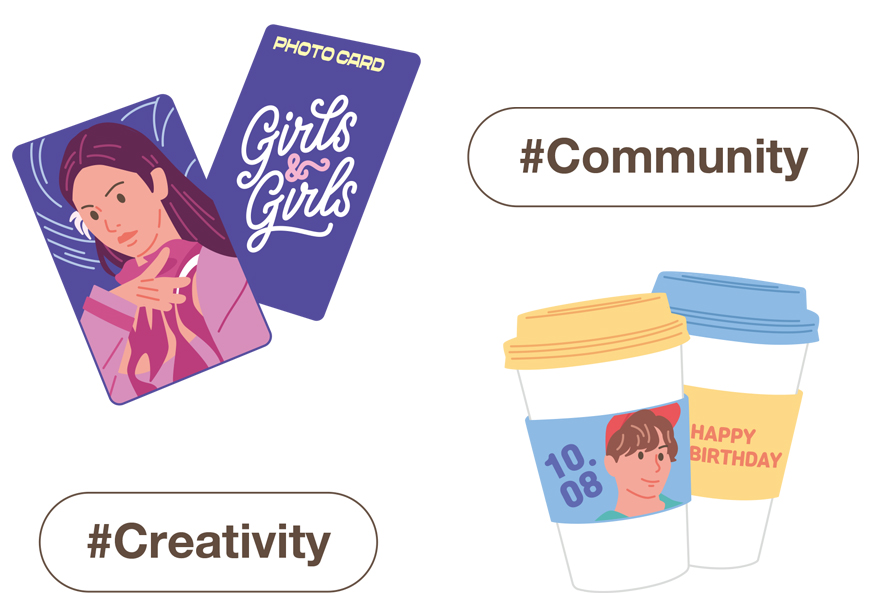
Fandom culture plays a significant role in shaping Korean trends. New movements frequently arise within these communities, reflecting the dynamic nature of Korea’s popular culture landscape. Notably, Korean fandoms can develop around a wide variety of interests, contributing to the country’s vibrant and evolving cultural environment.
Writer. Sung Ji Yeon
Illustrator. RYUGOON
“Fandom” combines “Fanatic”—meaning to follow something enthusiastically—with the suffix “-dom,” which denotes a group or domain. Essentially, it refers to a collective that pours unconditional affection and love into a particular celebrity.
Fandom exists wherever pop culture thrives, including in Korea. Korean fandom culture grew out of celebrity worship, particularly in the 1990s when today’s K-pop idol system took shape. People actively joined online communities to support specific entertainers and connect with fellow fans. They showed their allegiance by buying matching outfits and merchandise. This era also marked the beginning of fans showing boundless support through gifts and other gestures. Back then, most fandom members were women.
Over time, the generation that experienced fandom culture matured, and this culture naturally passed to the next generation. As artists’ concepts became more varied, fandom—once seen as exclusively for “young women”—expanded across all ages and genders. Throughout this evolution, voices both inside and outside fandoms grew stronger, pushing back against the excessive competition and exclusivity of earlier days and establishing the groundwork for today’s healthier fandom culture.
Members of various fandoms increasingly began to recognize and appreciate the cultures of other fan communities as well. Rather than presenting costly gifts, they opted to make charitable contributions in order to enhance their idols’ public reputation. Rather than simply consuming official content from agencies or studios, they began creating and enjoying fan-made content themselves. They occasionally expressed strong views that shaped official content and prompted change. Fandoms transformed from passive consumers into active forces that help develop and shape the celebrities they honored.

K-pop culture is deeply tied to Korean popular music culture. Countless K-pop artists have emerged, and with them, more people have been influenced by K-pop fandom culture. As a result, “fandom culture” has naturally flowed into Korean popular culture as a whole. This created the foundation for fandoms to form around virtually anything, not just K-pop artists.
People gather around things they can pour genuine passion into. And wherever they do, fandoms inevitably spring up. There are fandoms for trending Instagram characters, protagonists from webtoons or web novels and even zoo mascots. Brand fandoms exist where people love a particular brand’s message so much they never miss product launches or pop-up stores. Sports team fandoms are another example—recently, as baseball has gained popularity in Korea, baseball player fandoms have grown significantly.
These groups continue practices established by K-pop fandoms. They rent cafes to organize “birthday cafes” for their preferred celebrities, decorating the venue accordingly and providing a space where fans can meet and interact. They use public transportation like buses and subways to display supportive advertisements. When pop-up stores open, they line up to buy merchandise, and sometimes they organize their own events to create, exchange, or sell fan-made goods. They also create online content like promotional video memes to introduce their favorite stars to the general public. Additionally, they express creativity by writing new stories inspired by existing works. All of this adds up to voluntary promotion that spreads the word about whatever they’re passionate about. The fascinating thing is that fandoms treat all of this as just plain fun.
Wherever fandoms congregate, vibrant cultural exchange is already taking place. Sometimes new trends that capture the attention of the entire country emerge from these fandoms. A prominent example is the “doll” merchandise culture, in which enthusiasts craft dolls representing their favorite celebrities, meticulously style their hair and design custom-made clothing. This practice has further led to the development of specialized services supporting these activities.
Fandoms with this kind of clout have become essential to Korean pop culture. Brands, companies and public figures across different industries now shape their strategies and content around what fandoms want and like. Korean pop culture is slowly transforming into a system focused on winning over fans and connecting with them. In the end, fandoms have evolved from just being consumer groups into driving forces that shape new trends in Korean society. It’ll be exciting to see which fandom sparks the next big thing.
